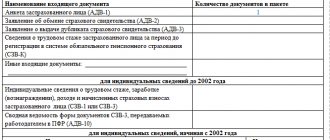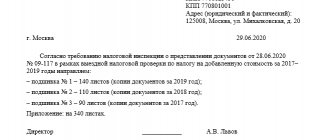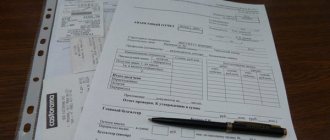Main purpose
Understanding how to create an inventory of documents allows you to establish an organization’s internal records management, which is necessary to control document flow:
- track the movement of documents between departments or outside the company and at any time determine the current location of the document you are looking for;
- optimize the work of the company and a corresponding reduction in resources, both temporary and human, which are spent on searching for the necessary data or restoring lost data.
Each company has the right to independently determine how to organize the movement of documentation, how to make transfer lists and what type they should have. There are no regulatory requirements in this part; there is a recommended form for an inventory of documents for transfer, which you can rely on when developing your own forms.
Who should draw up the document
Maintaining personal files falls within the competence of personnel specialists, therefore compiling an inventory of the documents stored in them is also their prerogative. But in some cases (for example, in small businesses), the inventory can be drawn up by the secretary or head of the company - the main thing is that the employee has a sufficient level of qualifications to fill out the document in the correct order and in its entirety. This is especially true now that the previously approved procedure for conducting personal affairs has been canceled and employees of enterprises in this process must rely only on their experience and generally accepted practice.
Transfer inventory, sample 2021
The form of the transfer inventory is approved by an internal act of the organization. It is desirable that it include the following sections:
- name of the organization where the documentation comes from;
- name of the organization where the package is being sent;
- date of compilation of the list;
- the serial number of each transferred unit in the package, its name, the number of sheets and copies - this information can be presented in the form of a table. It is advisable to indicate in it whether originals or copies are being transferred, and if copies, then certified or not;
- total number of sheets to be transferred;
- FULL NAME. and the position of the person transferring the package, and the signature of the recipient, as evidence that it was transferred.
The inventory is drawn up in two copies: for the transmitting and receiving parties.
If after filling out the form there are still empty lines, they should be crossed out with a pen.
Why is it necessary?
The purpose of the register is extremely simple - to simplify work, and as a result, increase the efficiency of the company.
When using the registry, the following tasks are solved:
speeds up work with documentation- simplifies the search for the necessary agreement or resolution
- a detailed report of each security is kept (date of signing, name)
- issued at the request of one of the employees
The register journal is maintained in written or electronic form. The latter option allows you to further simplify the creation and maintenance of records. To maintain a written version, no technological devices in the form of a computer are required.
The table indicates superficial information about the name, date of signing, conditions, duration of validity and other parameters of the document. In some cases, it is not necessary to study the original agreement or decree; the information specified in the register is sufficient.
Journaling in 1C, look at the video:
Main varieties
There are several possible classifications of the lists attached to the shipment. It is recommended that organizations develop their own template for each type. Depending on what kind of transfer the list accompanies, it may include:
- to internal, if papers are transferred within a legal entity from one division to another;
- to external ones, if it accompanies a package of papers sent to another organization.
Depending on the subject of the accompanying papers:
- financial statements;
- personnel papers;
- statutory documentation.
This list of types is not closed; each aspect of the organization’s activities is accompanied by a certain document flow that needs to be organized.
Finally, a special type of list is identified - delivery notes, drawn up for transferring a case to the archive, an example of which will be considered separately.
Registry rules
When registering the journal, the following rules must be observed:
when filled in by different people, the last column indicates who made the edit- technical errors in the registry are eliminated only on behalf of senior management
- when correcting inaccurate data, a written statement is written with information about the type of error and the person who made it
When registering the register in writing, the responsible person puts not only his signature, but also his personal seal. In many companies, the journal is kept electronically. This allows you to quickly find information about documents and keep track of papers.
An organization can simultaneously use a register in both written and electronic form. This option helps to avoid loss of information when a computer or server fails.
Specific design recommendations are given individually. When maintaining a register of agreements, it is required to indicate in the table not only the name and content, but the amount and duration of the document, as well as information about the parties who entered into the agreement.
Features of some types in the video:
How to correctly compile a list of papers for internal transfer
The internal inventory of documents (when transferring documents between departments of the organization, this is exactly what is drawn up) should be compiled in the form of a table. The form of the table and the amount of information that must be entered into it are determined by the company’s internal administrative documents. When considering how to correctly compile an inventory of documents for transfer, you should include the following sections:
- serial number of paper;
- index - an optional element of details, placed in exceptional cases when a large volume of documentation is transferred;
- date - refers to the date of registration of the paper, that is, the day when it was accepted for accounting in office work;
- title - should briefly reflect the essence of the paper;
- sheet numbers - the sheets of the transferred package must have continuous numbering, each act occupies one or another range of pages of the case;
- note - the field is provided in case the clerk needs to make any additional notes regarding a specific sheet;
- the total number of sheets in the transferred file;
- date of compilation, position, full name. and the signature of the originator.
You can use the following form and sample document transfer inventory:
Concept and definition
The register allows you to sort papers into categories and, if necessary, access them as quickly as possible. The tasks of the registry include storage, recording and transfer or issuance on demand.
The journal is maintained by one or more company employees. Responsible persons are determined by senior management. In addition to maintaining the register, the employee may have other responsibilities.
Delivery list of documentation
This is a special type of accompanying documentation compiled in connection with the transfer of the case to the archive. These lists contain additional columns:
- deadline dates - you must indicate until what date the paper should be stored. The date is determined in accordance with the archival storage norm, as a rule, it is five years;
- shelf life.
We recommend making an inventory of the documents being transferred and filling it out according to the template.
Legislative justification
The documentation inventory is carried out on the basis of these instructions:
- Recommendations for office work, approved by Rosarkhiv on December 23, 2009.
- Instructions for office work, approved by the Order of the Ministry of Culture.
- Central Bank instructions.
Documents reflected in the inventory must be properly systematized. First, papers of priority importance (orders, instructions) are recorded, followed by plans, correspondence and other documents.
A few words about the TORG-31 form
This unified form was established for use by Decree of the State Statistics Committee of December 25, 1998 No. 132. It became recommended for use from the beginning of 2013 (information of the Ministry of Finance of Russia No. PZ-10/2012). From now on, organizations decide for themselves what forms of primary information they should use: unified or independently developed.
If the company decides to develop the forms itself, then you need to remember that the required details of the primary accounting document are available. They are listed in paragraph 2 of Art. 9 Federal Law No. 402-FZ “Accounting Law”. The developed forms must be approved in the company’s accounting policies by a special order from the manager.
Register in electronic form
To maintain a journal in electronic form, it is recommended to use specialized programs. A popular solution is to use the Urayt: Contracts utility. With its help, you can create a journal of contracts and other papers.
You can also keep records using office applications preinstalled on your computer. You can create a table in Microsoft Excel. Among the advantages of this program are accessibility and simplicity. However, when working in groups, difficulties often arise, manual input errors appear and data are distorted. At the initial stage, Excel will be an excellent solution and will allow you to learn register management skills.
Among the advantages of the electronic format are:
ease of use (even a beginner can use it)- quick search by category
- ease of updating data and changing the status of papers
To work, you only need to purchase licensed programs.
Firstly, when using the license there will be no problems with the law. Secondly, licensed software has wider functionality and is regularly updated. With updates, bugs are eliminated and new features appear.
Keeping a documentation log is a relatively simple procedure that can significantly improve the efficiency of employees in the company. Organizations that do not keep records of papers face great difficulties when dealing with requests from tax and other government agencies, as well as during office work within the company.
Top
Write your question in the form below
Application benefits
Among the advantages of use are:
- saving time
- increasing the efficiency of the organization
It is recommended that all companies maintain a register, regardless of size and scope of activity. Over many years of work, a lot of papers, contracts, decrees and orders accumulate.
Supervisory authorities may require old documentation, which, if not properly stored, will be very difficult to find. When maintaining a register, paper is quickly identified by a unique number.
Maintaining records is not a mandatory requirement, but without it, it becomes difficult to work and search for queries. Lack of paper is not punishable by law. To get all the benefits of accounting, you need to properly carry out registration and maintenance. If you wish, you can seek help from remote specialists who will create a magazine in the company. In most cases, management is carried out by employees of companies whose activities are related to document flow.








